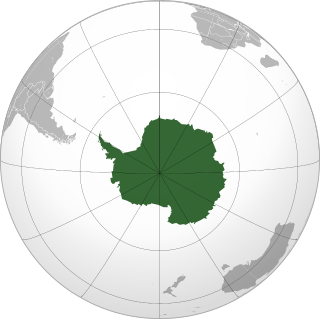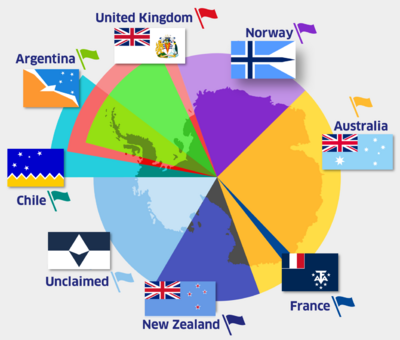More languages
More actions
| Antarctica | |
|---|---|
 | |
| Area | |
• Total | 14,200,000 km² |
| Population | |
• Estimate | 1,300 to 5,100 (seasonal) |
Antarctica is Earth's southernmost continent, and the only continent that is not permanently inhabited by any people despite sections being claimed by several countries. It contains the geographic South Pole, and is completely surrounded by the Southern Ocean. Since discovery Antarctica has been a target of imperialism, and even in modern day squabbles over sovereignty continue despite an agreement of peace on the continent.[1]
History[edit | edit source]
Discovery[edit | edit source]
Since the first documented discovery of the continent by Europeans in the 19th century, the European empires have been committed to claiming the land for themselves, enticed by the potential for exploiting minerals and other resources. Exploration began in earnest around the unknown continent with expeditions to the South Pole itself being undertaken in 1911, one by Norwegian Roald Amundsen, and another by Briton Robert Scott.[1]
Division of territory[edit | edit source]
In 1908 the first modern claim to Antarctica was made by the British, when South Georgia, the Sandwich Islands, the South Orkneys, South Shetlands and Graham Land on mainland Antarctica itself were claimed as part of the territory of the Falkland Islands. This area, known as the Falkland Dependency, was defined precisely in 1917, between the 20th and 80th meridians west of Greenwich. British ambitions to the continent would only continue to grow with them committed to claiming the entirety of the continent for themselves, a claim they would only retract in the 1930s.[1]
In 1923 Britain continued claiming sections of the continent using its colony of New Zealand to claim the Ross Dependency, 160° east and 150° west and south of the 60th parallel. In 1924 France in the same way used its colony of Madagascar to claim the Crozet Islands and a section of Antarctica known as Terre Adélie. In 1933 Britain once again reinforced its claims and claimed a huge section between longitudes 160° and 45° east – excluding Terre Adélie – using its dominion of Australia while France meanwhile officialised the limits of Terre Adélie in 1938. In 1939 Norway pushed their own claim for a sector between the Falkland dependency and the Australian territories this would be the last claim made before all claims began to be questioned after the end of the Second World War.[1]
The United States also launched expeditions in Antarctica, but instead of claiming a direct share of the continent they influenced affairs by advocating for a new form of Monroe Doctrine, condemning the influence of Europeans in Antarctica in the same way it does the Americas. 1934, the US insisted that the discovery of new territories, does not equate ownership unless accompanied by occupation, and extended its protection to the 1940 claims of Chile and Argentina which straddled the claims of the UK.[1]
Antarctic Treaty[edit | edit source]
On 1 December 1959 the Antarctic Treaty, which applied to the territories south of the 60th parallel, was ratified by 12 states, to ensure “in the interests of all humankind that Antarctica shall continue forever to be used exclusively for peaceful purposes.” It put on hold the territorial claims of the signatories without demanding that they renounce claims to sovereignty over the continent whilst establishing a new balance of power in the favour of US imperialism. In 1991 the Protocol of the Antarctic Treaty was adapted with the addition of the Madrid Protocol, which made Antarctica a nature reserve devoted to peace and science.[1]
21st Century[edit | edit source]
Although no country officially presses for sovereignty over the continent despite maintaining claims in the present the continent is littered with scientific outposts. Countries which have scientific bases in Antarctica include: Germany, Belgium, Bulgaria, Spain, France, Finland, Italy, Norway, the United Kingdom, Sweden, Russia, and Ukraine.[1]
Territorial Claims[edit | edit source]

Sections of Antarctica are claimed by seven different countries, with the UK, Chile, and Argentina having overlapping claims.[2]
| Country | Territory | Territory limits |
|---|---|---|
| Adélie Land | 142°2′E to 136°11′E | |
| British Antarctic Territory | 80°0′W to 20°0′W | |
| Ross Dependency | 160°0′E to 150°0′W | |
| Australian Antarctic Territory | 44°38′E to 136°11′E, and 142°2′E to 160°00′E | |
| Queen Maud Land | 20°00′W to 44°38′E | |
| Chilean Antarctic Territory | 90°0′W to 53°0′W | |
| Argentine Antarctica | 74°0′W to 25°0′W | |
| (Unclaimed territory) | Marie Byrd Land | 150°0′W to 90°0′W |
